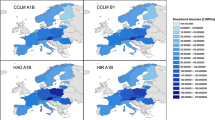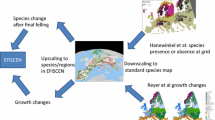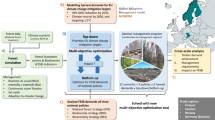Abstract
The purpose of this study was to optimize forest management for a forest region (the total area of forest and scrub land 1.54 mill. ha) under changing climate by using the large-scale forestry scenario model MELA and sample plot data from the geo-referenced National Forest Inventory (NFI). The MELA model is based on integrated simulation and optimisation; in the simulation it utilises empirical tree-level models into which the impacts of climate change were introduced by transfer variables derived by using the physiological model FinnFor. Six scenarios with differences in climate and forest management were defined. In simulations, the accelerating tree growth caused by climate change resulted in an increase in maximum sustainable removal of trees at regional level. Changes in regionally optimized forest management were also detected during the analysis period of 30 years; the proportion of thinnings increased because the stands fulfilled the thinning requirements earlier than in the current climate. This study was the first attempt to solve endogenously maximum sustainable timber production and corresponding forest management at the regional level under different climate scenarios. When implemented in the MELA system, which is widely used in Finnish forestry, the transfer variables offer means of disseminating the results from physiological studies to planning of adjustment and mitigation measures under changing climate.
Similar content being viewed by others
References
Baldwin Jr VC, Burkhart HA, Westfall JA, Peterson KD (2001) Linking growth and yield and process models to estimate impact of environmental changes on growth of loblolly pine. Forest Science 47(1):77–82.
Battaglia M, Sands PJ (1998) Process-based forest productivity models and their application in forest management. Forest Ecology and Management 102:13–32.
Cajander AK (1926) The theory of forest types. Acta Forestalia Fennica 29(3):1–108.
Cajander AK (1949) Metsätyypit ja niiden merkitys. Acta Forestalia Fennica 56:5–69 (in Finnish).
Carter T, Posch M, Tuomenvirta H (1995) SILMUSCEN and CLIGEN User's Guide: Publications of the Academy of Finland 5/95, p 62.
Carter TR, Bärlund I, Fronzek S, Kankaanpää S, Kaivo-oja J, Luukkanen J, Wilenius M, Tuomenvirta H, Jylhä K, Kahma K, Johansson M, Boman, H, Launiainen J, Laurila T, Lindfors V, Tuovinen J-P, Aurela M, Syri S, Forsius M, Karvosenoja N (2002) The Finsken global change scenarios. In: Käyhkö J, Talve L (eds) Understanding the global system: The Finnish perspective, FIGARE 1999–2002, pp 27–40 (http://figare.utu.fi/UGS/index.html).
Ceulemans R, Mousseau M (1994) Effects of elevated atmospheric CO2 on woody plants: a review. New Phytol 127:425–446.
Chen W, Chen J, Cihlar J (2000) An integrated terrestrial ecosystem carbon-budget model based on changes in disturbance, climate, and atmospheric chemistry. Ecological Modelling 135:55–79.
Chertov OG, Komarov AS Tsiplianovsky AM (1999a) A combined simulation model of Scots pine, Norway Spruce and Silver birch ecosystems in the European boreal zone. Forest Ecology and Management 116:189–206.
Chertov O, Komarov AS, Karev GP (1999b) Modern approaches in forest ecosystem modeling, European Forest Institute Research Report 8. Brill, Leiden, The Netherlands, p. 116.
Constable JVH, Friend AL (2000) Suitability of process-based tree growth models for addressing tree response to climate change. Environmental Pollution 110:47–59.
Ehman JL, Fan W, Randolph JC, Southworth J, Welch NT (2002) An integrated GIS and modelling approach for assessing the transient response of forests of the southern Great Lakes region to a doubled CO2 climate. Forest Ecology and Management 155:237–255.
FFCS 1002-1:2003: (2003) Criteria for group certification for the area of a forestry centre. Standard approved by the Working Group of Forest Certification Standards on 29 September 2003. p. 17.
Hättenschwiler S, Miglietta F, Rasch A, Körner S (1997) Thirty years of in situ tree growth under elevated CO2: a model for future responses? Global Change Biology 3:463–471.
He HS, Mladenoff DJ, Crow TR (1999) Linking an ecosystem model and a landscape model to study forest species response to climate warming. Ecological Modelling 114:213–233.
Hoen HF, Eid T, Okseter P (2001) Timber production possibilities and capital yields from the Norwegian forest area. Silva Fennica 35(3):249–264.
Huntingford C, Cox PM, Lenton TM (2000) Contrasting responses of a simple terrestrial ecosystem model to global change. Ecological Modelling 134:41–58.
Hynynen J (1993) Self-thinning models for even-aged stands of Pinus sylvestris, Picea abies and Betula bendula. Scandinavian Journal of Forest Research 8(3):326–336.
Hynynen J, Ojansuu R, Hökkä H, Salminen H, Siipilehto J, Haapala P (2002) Models for predicting stand development in MELA System, Finnish Forest Research Institute, Research Papers 835 p. 116.
IPCC (2001) Climate Change (2001) Impacts, Adaptation and Vulnerability. Contribution of Working Group II to the Third Assessment Report of the Intergovernmental Panel on Climate Change, In: McCarthy JJ, Canziani OF, Leary NA, Dokken DJ, White, KS (eds) Cambridge University Press, Cambridge, United Kingdom, p. 1005.
Karjalainen T, Pussinen A, Kellomäki S, Mäkipää R (1999) Scenarios for the carbon balance of Finnish forests and wood products. Environmental Science & Policy 2:165–175.
Kellomäki S, Väisänen H (1997) Modelling the dynamics of the forest ecosystem for climate change studies in the boreal conditions. Ecological Modelling 97:121–140.
Kellomäki S, Karjalainen T, Väisänen H (1997) More timber from boreal forests under changing climate? Forest Ecology and Management 94:195–208.
Kimmins JP, Mailly D, Seely B (1999) Modelling forest ecosystem net primary production: The hybrid simulation approach used in FORECAST. Ecological Modelling 122:195–224.
Kirschbaum MUF, King DA, Comins HN, McMurtrie RE, Medlyn BE, Pongracic S, Murty D, Keith H, Raison RJ, Khanna PK, Sheriff DW (1994) Modeling forest response to increasing CO2 concentration under nutrient-limited conditions. Plant Cell Environ 17:1081–1099.
Korhonen KT, Tomppo E, Henttonen H, Ihalainen A, Tonteri T, Tuomainen T (2001) Pohjois-Karjalan metsäkeskuksen alueen metsävarat 1966–2000 Metsätieteen aikakauskirja 3B/2001: 495–576. (in Finnish).
Lappi J (1992) JLP: A linear programming package for management planning. The Finnish Forest Research Institute, Research Papers 414, p. 134.
Lasch P, Lindner M, Erhard M, Suckow F, Wenzel A (2002) Regional impact assessment on forest structure and functions under climate change – the Brandenburg case study. Forest Ecology and Management 162:73–86.
Lexer MJ, Hönninger K, Scheifinger H, Matulla Ch, Groll N, Kromb-Kolb H, Schaudauer K, Starlinger F, English M (2002) The sensitivity of Austrian forests to scenarios of climatic change: a large-scale risk assessment based on a modified gap model and forest inventory data. Forest Ecology and Management 162:53–72.
Linder S (1987) Responses of water and nutrition in coniferous ecosystems. In: Schulze E-D, Zwölfer H (eds) Potentials and limitations of ecosystem analysis. Springer, Berlin, pp. 180–222.
Lindner M (2000) Developing adaptive forest management strategies to cope with climate change. Tree Physiology 20:299–307.
Liu J, Ashton PS (1995) Individual-based simulation models for forest succession and management. Forest Ecology and Management 73:157–175.
Mäkelä A, Landsberg J, Ek AR, Burk TE, Ter-Mikaelian M, Ågren GI, Oliver CD, Puttonen P (2000) Process-based models for forest ecosystem management: current state of the art and challenges for practical implementations. Tree Physiology 20:289–298.
Mäkipää R, Karjalainen T, Pussinen A, Kellomäki S (1999) Effects of climate change and nitrogen deposition on the carbon sequestration of a forest ecosystem in the boreal zone. Can J For Res 29:1490–1501.
Matala J, Hynynen J, Miina J, Ojansuu R, Peltola H, Sievänen R, Väisänen H, Kellomäki S (2003) Comparison of a physiological model and a statistical model for prediction of growth and yield in boreal forests. Ecological Modelling 161:95–116.
Matala J, Ojansuu R, Peltola H, Sievänen R, Kellomäki S (2005) Introducing effects of temperature and CO2 elevation on tree growth into a statistical growth and yield model. Ecological Modelling 181:173–190.
Matala J, Ojansuu R, Peltola H, Raitio H, Kellomäki S (2006) Modelling the response of tree growth to temperature and CO2 elevation as related to the fertility and current temperature sum of a site, Submitted manuscript.
Van der Meer PJ, Jorritsma ITM, Kramer K (2002) Assessing climate change effects on long-term forest development: adjusting growth, phenology, and seed production in a gap model. Forest Ecology and Management 162:39–52.
Mikkelä H, Sampo S, Kaipainen J (eds) (2000) The state of forestry in Finland 2000. Criteria and indicators for sustainable forest management in Finland, The final report of the Working Group Steering the Further Criteria and Indicators for Sustainable Forest Management, Ministry of Agriculture and Forestry, Publications 5a/2000, p 102.
Mohren GMJ, Burkhart HE (1994) Contrasts between biologically-based process models and management oriented growth and yield models. Forest Ecology and Management 69:1–5.
Nabuurs, G-J, Päivinen R (1996) Large-scale forestry scenario models – a compilation and review:European Forest Institute Working Paper No. 10. Joensuu, Finland, p 174.
Nabuurs G-J, Schelhaas M-J, Pussinen A (2000) Validation of the European Forest Information Scenario Model (EFISCEN) and a projection of Finnish forests. Silva Fennica 34(2):167–179.
Nabuurs G-J, Pussinen A, Karjalainen T, Erhard M, Kramer K (2002) Stemwood volume increment changes in European forests due to climate change – a simulation study with the EFISCEN model. Global Change Biology 8:304–316.
Niemelä P, Chapin FS III, Danell K, Bryant JP (2001) Herbivory-mediated responses of selected boreal forests to climatic change. Climatic Change 48:427–440.
Nuutinen T (2003) Large-scale forest inventory and scenario modelling. In Burley J, Evans J. Youngquist JA (eds) Encyclopedia of Forest Sciences: Elsevier, pp 410–414.
Nuutinen T, Kellomäki S (2001) A comparison of three modeling approaches for large-scale forest scenario analysis in Finland. Silva Fennica 35(3):299–308.
Nuutinen T, Hirvelä H, Hynynen J, Härkönen K, Hökkä H, Korhonen KT, Salminen O (2000) The role of peatlands in Finnish wood production - an analysis based on large-scale forest scenario modeling. Silva Fennica 34(2):131–153.
Nuutinen T, Hirvelä H (2001) Valtakunnan metsien 9. inventointiin perustuvat hakkuumahdollisuusarviot vuosille 2000–2029 Pohjois-Karjalan metsäkeskuksen alueella. Metsätieteen aikakauskirja 3B/2001. (in Finnish).
Päivinen R, Roihuvuo L, Siitonen M (1996) Large-scale forestry scenario models: experiences and requirements:European Forest Institute Proceedings No. 5. Joensuu, Finland, p 318.
Parry M (ed) (2000) Assessment of potential effects and adaptations for climate change in Europe, The European Acacia Project. Report of a concerted action of the Environment Programme of the Research Directorate General of the Commission of the European Community, Jackson Environment Institute, School of Environmental Sciences, University of East Anglia, United Kingdom, p 320.
Peltola H, Kellomäki S, Väisänen H (1999) Model computations of the impact of climatic change on the windthrow risk of trees. Climatic Change 41:17–36.
Peltola H, Kilpeläinen A, Kellomäki S (2002) Diameter growth of Scots pine (Pinus sylvestris) trees grown at elevated temperature and carbon dioxide concentration under boreal conditions. Tree Physiol 22:963–972.
Peng C (2000) Understanding the role of forest simulation models in sustainable forest management. Environmental Impact Assessment Review 20:481–501.
Peng C, Jiang H, Apps MJ, Zhang Y (2002a) Effects of harvesting regimes on carbon and nitrogen dynamics of boreal forests in central Canada: A process model simulation. Ecological Modelling 155:177–189.
Peng C, Liu J, Dang Q, Apps MJ, Jiang H (2002b) TRIPLEX: A generic hybrid model for predicting forest growth and carbon and nitrogen dynamics. Ecological Modelling 153:109–130.
Percy KE, Awmack CS, Lindroth RL, Kubiske ME, Kopper BJ, Isebrands JG, Pregitzer KS, Hendrey GR, Dickson RE, Zak DR, Oksanen E, Sober J, Harrington R, Karnosky DF (2002) Altered performance of forest pests under atmospheres enriched by CO2 and O3. Nature 420:403–407.
Pohjois-Karjalan metsäohjelma 2001–2005: (2002) Pohjois-Karjalan metsäkeskus p 76. (in Finnish).
Porté A, Bartelink HH (2002) Modelling mixed forest growth: a review of models for forest management. Ecological Modelling 150:141–188.
Rathgeber C, Nicault A, Kaplan JO, Guiot J (2003) Using a biogeochemistry model in simulating forests productivity responses to climatic change and [CO2] increase: Example of Pinus halepensis in Provence (south-east France). Ecological Modelling 166:239–255.
Redsven V, Anola-Pukkila A, Haara A, Hirvelä H, Härkönen K, Kettunen L, Kiiskinen A, Kärkkäinen L, Lempinen R, Muinonen E, Nuutinen T, Salminen O, Siitonen M (2004) MELA2002 Reference Manual (2nd edition), The Finnish Forest Research Institute, p 606.
Ripley BD (1981) Spatial Statistics: Wiley, New York, p 252.
Siitonen M (1993) Experiences in the use of forest management planning models. Tiivistelmä: Kokemuksia mallien käytöstä metsätalouden suunnittelussa. Silva Fennica 27(2):167–178.
Siitonen M, Härkönen K, Hirvelä H, Jämsä J, Kilpeläinen H, Salminen O, Teuri M (1996) MELA Handbook – 1996 Edition, The Finnish Forest Research Institute, Research Papers 622, p 452.
Strandman H, Väisänen H, Kellomäki S (1993) A procedure for generating synthetic weather records in conjunction of climatic scenario for modelling of ecological impacts of changing climate in boreal conditions. Ecological Modelling 70:195–220.
Sykes MT (2001) Modelling the potential distribution and community dynamics of lodgepole pine (Pinus contorta Dougl. Ex. Loud.) in Scandinavia. Forest Ecology and Management 141:69–84.
Talkkari A (1996) Regional predictions concerning the effects of climate change on forests in southern Finland. Silva Fennica 30(2–3):247–257.
Talkkari A Hypén H (1996) Development and assessment of a gap-type model to predict the effects of climate change on forests based on spatial forest data. Forest Ecology and Management 83:217–228.
Talkkari A, Kellomäki S, Peltola H (1999) Bridging a gap between a gap model and a physiological model for calculating the effect of temperature on forest growth under boreal conditions. Forest Ecology and Management 119:137–150.
Väisänen H, Kellomäki S, Strandman H (1994) A model for simulating the effects of changing climate on the functioning and structure of the boreal forest ecosystem: an approach based on object-oriented design. Tree Physiology 14:1081–1095.
Wang K-Y, Kellomäki S, Laitinen K (1995) Effect of needle age, long-term temperature and CO2 treatment on the photosynthesis of Scots pine. Tree Physiol 15:211–218.
Yrjölä T (2002) Forest management guidelines and practices in Finland, Sweden and Norway: European Forest Institute, Internal Report No. 11, p 46.
Zhang Q, Alfaro RI, Hebda RJ (1999) Dendroecological studies of tree growth, climate and spruce beetle outbreaks in Central British Columbia, Canada. Forest Ecology and Management 121:215–225.
Zheng D, Freeman M, Bergh J, Rosberg I, Nilsen P (2002) Production of Picea abies in South-east Norway in Response to Climate Change: A Case Study Using Process-based Model Simulation with Field Validation. Scandinavian Journal of Forest Research 17:35–46.
Author information
Authors and Affiliations
Corresponding author
Rights and permissions
About this article
Cite this article
Nuutinen, T., Matala, J., Hirvelä, H. et al. Regionally optimized forest management under changing climate. Climatic Change 79, 315–333 (2006). https://doi.org/10.1007/s10584-006-9098-2
Received:
Accepted:
Published:
Issue Date:
DOI: https://doi.org/10.1007/s10584-006-9098-2




